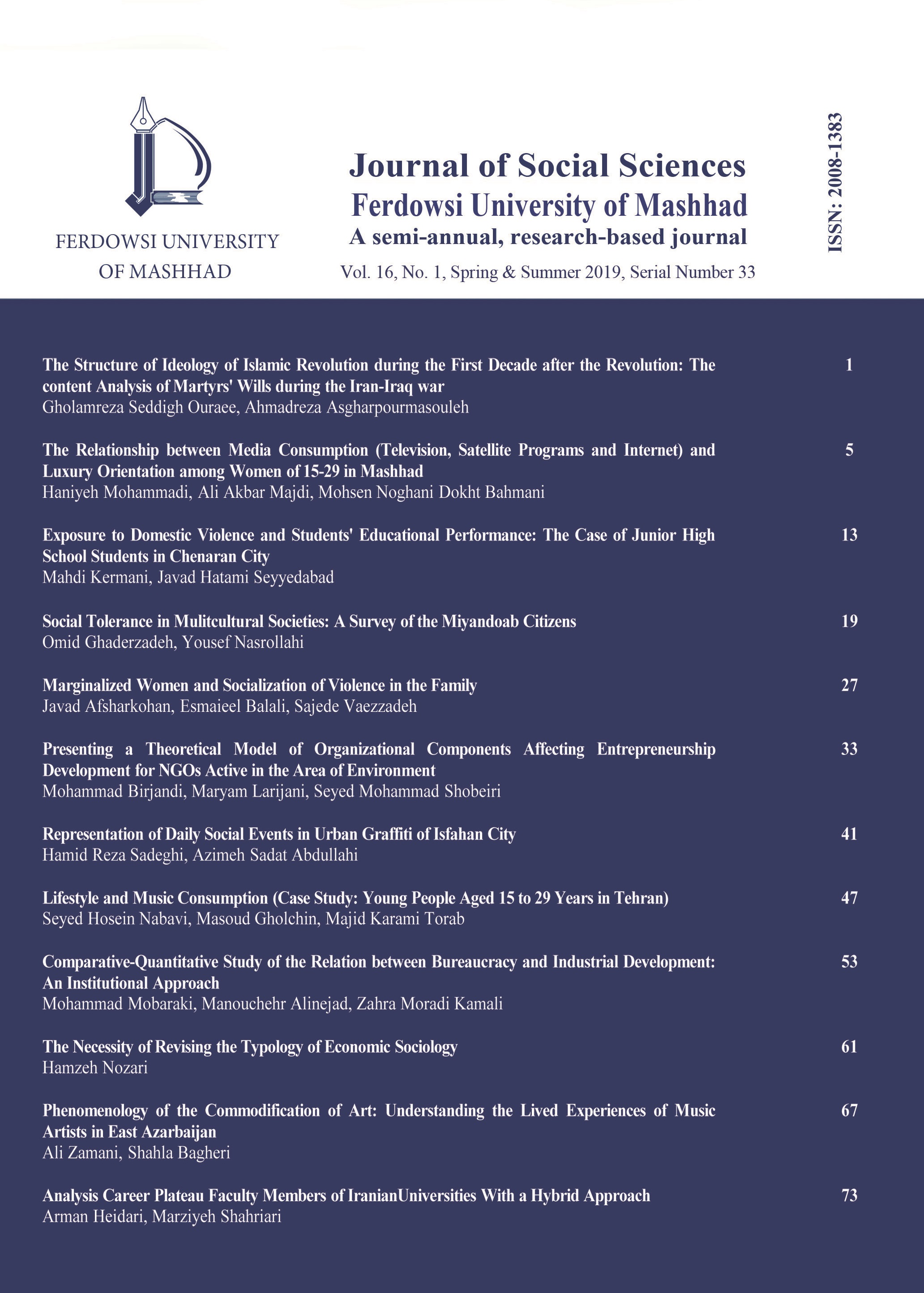Document Type : Scientific-Research
Authors
University of Kharazmi
Abstract
Extended Abstract
Introduction
Music consumed in the Iranian society is devoid of any local or authentic origins. The growth of new types of music appears to be in harmony with changes that has occurred in the lifestyle of individuals and subsequently, their taste, especially among the youth. According to North and Hargreaves, studies conducted on musical priorities (consumption) suggest that these priorities must be linked to different types of lifestyle choices; they concluded that there are numerous relations between various dimensions of lifestyles and musical preferences. The types of these relations are somewhat consistent with previous studies on taste publics in which high culture and low culture are differentiated (North & Hargreaves, 2007, p. 197). Certain researchers (Cockrill, Sullivan, & Norbury, 2011) believe that the extent of music consumption results from the lifestyle of the youth, both in qualitative and quantitative terms. As a result it appears that lifestyle plays a significant role in the type and extent of the youth’s music consumption. Accordingly, the research question is: How and why lifestyle affects music consumption in the Iranian society?
Review of Literature
In Bourdieu’s theory, “habitus” is a central concept that explains lifestyles as the systematic products of habitus (Bourdieu, 2012). According to Bourdieu, “homogeneity of habitus in a certain group is the basis for different lifestyles in a society” (Bonnewitz, 2012). Habitus influences lifestyle formation through taste, and in turn, taste acts as signs of class (Bourdieu, 2012). He believes that nothing that can show one’s class except for their musical taste (Bourdieu, 2012). Needless to say, he also believes that habitus itself is influenced by different types of capital.
Method
The method used in this study was surveys. The total population of the study included the youth (between the ages of 15-29) living in Tehran out of whom, a sample population of 384 and ultimately 400 was estimated using multistage cluster sampling. The main hypotheses include: 1. there appear to be a significant statistical relation between different types of capital, i.e. economic, social and cultural, and music consumption; 2. there appears to be a significant statistical relation between lifestyle (cultural consumption, body management, leisure time) and music consumption. To evaluate the validity and reliability of instruments and measures, formal validity and Cronbach’s alpha were employed, respectively.
Results and Discussion
The findings of the study showed that: a. the higher the economic capital, the more Western and pop music are consumed; and b. the higher the real social capital, the more pop music is consumed; meanwhile, the higher the virtual social capital, the more traditional and religious music are consumed. Additionally, c. the higher the cultural capital, the more traditional music is consumed. 4. Higher extent of cultural consumption results in a higher extent of listening to traditional music; 5. There is no relation between body management and music consumption (except for traditional); 6. The longer the duration of leisure time, the more traditional and pop music are consumed.
Conclusion
Bivariate explanations show that contrary to the initial assumption, the lifestyle of the youth does not affect their tendency towards new music; there are other causes and mechanisms at work. Multivariate explanations also revealed that cultural capital affects the lack of consuming new types of music more than others. In both explanations, the relation between economic capital and Western music was confirmed. This shows that cultural and economic capital involve contradictory roles in the consumption of new (inauthentic) music: economic capital facilitates their consumption while cultural capital restricts it. The results of this study are to some extent consistent with those of Fazeli, Ghasemi, and Samim.
Nevertheless, why is there no apparent connection between the lifestyle of the youth and new (non-traditional) music? It appears that the youth have precise information on the Western lifestyles through mass communications in a variety of ways; accordingly, these individuals who enjoy a relatively high income from their families would create their new special lifestyle through the integration of the Western lifestyle with theirs.
In this new lifestyle, income plays a role of utmost importance. Their parents’ income (or their own) enables them to act effectively in shaping their own lifestyle. Income level is very effective in shaping different aspects of capital; and these different aspects themselves are considerably influential in shaping various components of lifestyle (cultural consumption, body management, and leisure). Consequently, as Bourdieu suggested as well, capitals play effective roles in determining lifestyle through habitus and class-related tastes within each field; in turn, lifestyle also plays an effective role in indicating the extent and type of music consumption.
Keywords

Send comment about this article